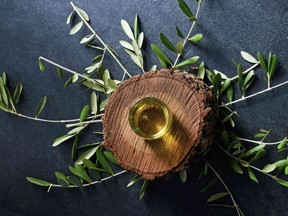On this journey of gastronomy from Seville to Jaen, olive oil takes centre stage

Reviews and recommendations are unbiased and products are independently selected. Postmedia may earn an affiliate commission from purchases made through links on this page.
By Sara Waxman
It doesn’t seem to matter that there is a transportation strike in Seville, Spain, just a few weeks before Easter. Walking through the streets of this splendid ancient city is awe-inspiring. Strolling past the many basilicas and the huge Gothic cathedral I make a major discovery. The Macarena is not simply a dance for teenagers, it is Seville’s most revered image, the Virgin of Hope.
For the past week, our group of Canadian importers, brokers and distributors have spent mornings tasting olive oil and seeing its step-by-step production in vast, environmentally responsible refineries, labs and factories; places where production can exceed 200,000 kilograms of oil a day. Our tutored tastings involve cobalt blue tasting vessels, so that our analysis is not swayed by colour and only our taste-buds prevail. We then indulge in a traditional, luxurious, three-hour lunch – a habit we are now finding hard to break.

A few of my Canadian colleagues have opened their Swiss Army knives and begun to slice up the produce of the land. Aromatic red and yellow peppers, tomatoes, and cucumbers make a colorful and delectable arrangement on paper plates. They sprinkle salt from a shaker snatched from the hotel breakfast table. Knives cleaned, they cut a baguette into chunks, and create a fruit course. Huge ripe strawberries, fresh dates still on their stems, crispy golden apples.
Everything is laid out on cardboard boxes they’ve set up in the aisle to serve as a table. But wait, I have a contribution to make, a small bottle of Verdlino, green-gold extra Virgin olive oil that I had been saving in my purse for just such an emergency. Olive oil is the lifeblood that runs through the veins of this beautiful sunlit country. Our humble, spontaneous repast culminates a week of exceptionally fine dining.

For this Canadian, ending the meal right now would be perfect, but we’re just at the midway point. Crisp confit of duck, scalloped potatoes, and a new sensation for me, dried chestnut purée liberally laced with Sherry. By the time dessert arrives, almost three hours have passed. Puff pastry profiteroles with warm almond and mint sauce are certainly worth the wait. And now? There is only one activity on our schedule: Siesta.

We’re curious as to why the place is empty. We learn what the reason is: an important soccer game on TV keeps the crowds away, and sure enough minutes after the game is ended, the regulars start piling in. Sliced cod, smoked salmon, anchovies, tuna, fresh white asparagus–all marinated in fresh olive oil. Tiny potatoes, dressed with oil and vinegar. Olives, capers on stems and wonderful crisp cloves of garlic with the center core removed, are pickled in brine. With a loaf of fresh bread, this is the kind of meal that I love. I begin dreaming about retiring to a small villa in Spain…

Olive cultivation was probably introduced into Spain towards the end of the second millennium before Christ. Today, about 3,000 years later, almost 50 per cent of Europe’s oil production is in Spain. The fruit is still picked by shaking the trees and letting the olives fall onto cloth-covered ground, then processed using age-old methods.
After washing, the olives are crushed into paste and stacked on hydraulic presses that press out the oily “must”. They are left to settle, while the oil separates and floats to the top of the vegetable water. Stringent testing in the lab denotes the acidity level: Extra Virgin is the first pressing of olives shaken from trees; Virgin is pressed from olives that have fallen onto the ground (fermentation begins immediately) and mixed with olives shaken from the tree.
Armed with specific vocabulary used by tasters—almond, bitter, sweet, fruity, grassy, apple, pungent—and having by now swallowed about a gallon of olive oil, I’m determined to put my newfound knowledge to the test at my next meal.

But first, tapas: crispy baby octopus and squid; the crunch of deep-fried anchovies–four stuck together to form a fan–sea snails; grilled crayfish; marinated clams; and endives filled with Roquefort. By 3 p.m. every table in this two-room restaurant is filled. Several of us take a cue from what’s going on around us and order a huge sea-bass, embedded in salt, and baked on a wooden tray. We are amazed at the alacrity and skill with which the waiter cracks open the salt, bones the fish, and serves the sweet and delicate white flesh.
As for the tasting notes of my olive oil, my now-educated palate says grassy, fruity perfume with low acidity. Extra Virgin of course.